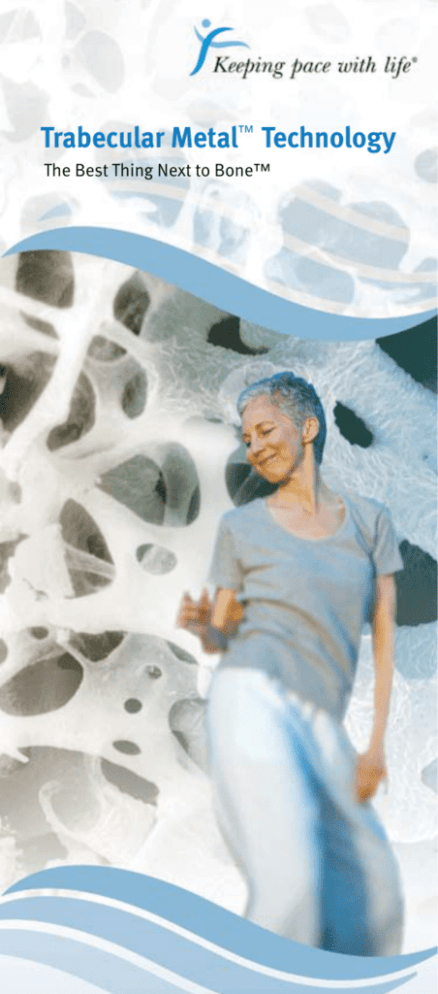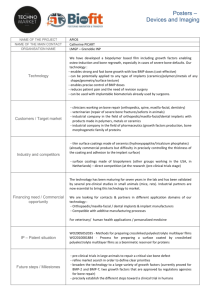Trabecular Metal™ Technology
advertisement

Trabecular Metal™ Technology The Best Thing Next to Bone™ Trabecular Metal Technology The Best Thing Next to Bone When you need a hip, knee, shoulder or spine implant, you want assurance that your implant is made from the highest quality material, and that it’s as close to the real thing as possible. Implants today are made of many materials, but there is only one metal that acts most closely like healthy bone:1,2 Zimmer® Trabecular Metal Technology. Trabecular Metal implants are, quite simply, The Best Thing Next to Bone™. What is Trabecular Metal Material? There are 206 bones in the adult human body. Although they give the appearance of being rock solid, bones are actually complex living tissue, composed of five primary parts: Compact Bone is the hard, strong, solid outer layer, which gives bones their whitish color. Periosteum – Located on the top, surface layer of the compact bone, the periosteum is a thin membrane containing the nerves and blood vessels that provide nourishment and sensation to bone tissue. Cancellous (Spongy) Bone – Located inside the hard outer layer, cancellous bone looks like a sponge and contains bone marrow. It is made up of a mesh-like network of tiny pieces of bone called trabeculae. Bone Marrow – Found in many bones, bone marrow is located inside the cancellous bone an makes most of your red and white blood cells and platelets. Subchondral Bone is the smooth tissue at the ends of bones, which is covered with cartilage. Named after the trabeculae found in the inside layer of your bones, Zimmer Trabecular Metal material resembles natural bone in appearance and dynamics: it is extremely strong yet flexible, and very porous, resembling a sponge. Years of scientific research and clinical results show that Trabecular Metal Technology is truly The Best Thing Next to Bone. What is the advantage of Trabecular Metal Technology over other joint replacement materials? In addition to being the orthopaedic metal that more closely resembles the physical and mechanical properties of healthy bone, Zimmer Trabecular Metal Technology has been clinically shown to have several advantages over other implant materials: • Greater initial stability. • Greater flexibility – it moves with the bone more naturally than other orthopaedic implant materials. • Allows rapid and extensive bone in-growth1,3 Why is bone in-growth important? Joint and spine surgery and bone replacement involves removing or resurfacing damaged surfaces and restoring them with artificial implants. Implants are secured to human bone in one of two ways – they are either cemented (cement is used to secure the implant to the bone) or cementless (natural human bone grows into, or heals directly to, the artificial implant). Several factors determine which method is used; most notably the quality of the natural bone to which the implant must adhere. Trabecular Metal Implants have the porosity and structure that allows for extensive bone in-growth, which creates a bond between the implant and the bone, and eliminates the need for bone cement. For patients who have acceptable bone quality, cementless techniques are the preferable way to attach implants to existing human bone. Why is porosity important in an implant? Bone is living tissue that grows into your implant, incorporating it into your body. The more porous the implant material – in other words, the more nooks and crannies – the more space is available for bone to grow in and secure the implant. Whereas other materials used for orthopaedic implants are only 35 percent to 50 percent porous, Trabecular Metal material is 75-80 percent porous1,2,3. Sintered Beads (35-50% porous) Fiber Metal Mesh (35-50% porous) Trabecular Metal Technology (75-80% porous) Why is flexibility important? Although sturdy, healthy human bone has a certain degree of flexibility to withstand the body’s weight, and daily wear and tear. Trabecular Metal Implants possess flexibility similar to bone, whereas other implant materials are far more rigid. Studies have indicated that implant materials that don’t flex well can cause bones to recede and lose strength over time5,6,7. How is Trabecular Metal Material used? Trabecular Metal material is used in hundreds of hip, knee, shoulder and spine implants. Zimmer, a global leader in orthopaedics, is the only company that offers this material. Whereas other porous joint replacement materials can only be coated or sprayed onto orthopaedic implants, Trabecular Metal material can be used to create an entire implant. This material also may be infused or bonded to other types of implants in the areas that come in contact with your natural bone, to allow bone in-growth. Trabecular Metal Implants are placed by orthopaedic surgeons via traditional joint replacement surgery and Zimmer’s less-invasive Minimally Invasive Solutions™ (MIS™) techniques. For additional information, please visit: www.zimmer.com To learn more about Zimmer orthopaedic implants and procedures, or to find a surgeon, call toll free: or visit 1-877-447-5634 www.pacewithlife.com A global leader in the provision of high-quality, hands-on education and training for orthopaedic surgeons. 97-2100-710-00 10ML Printed in USA ©2006 Zimmer, Inc. 1 JD Bobyn, SA Hacking, JJ Krygier, SP Chan, KK Toh, M Tanzer, “Characterization of a New Porous Tantalum Biomaterial for Reconstructive Surgery”, 66th Annual AAOS, Anaheim, CA, Feb 4-8, 1999. Scientific exhibit. 2 DA Shimko, VF Shimko, EA Sander, KF Dickson, EA Nauman, “Effect of Porosity on the Fluid Flow Characteristics and Mechanical Properties of Tantalum Scaffolds”, published on-line February 2005 in Wiley Interscience (www.interscience.wiley.com) 3 JD Bobyn, GJ Stackpool, SA Hacking, M Tanzer, JJ Krygier, “Characteristics of Bone In-Growth and Interface Mechanics of a New Porous Tantalum Biomaterial”, The Journal of Bone and Joint Surgery (British), Sep 1999, 81-B No. 5, pp 907-914. 5 CL Levitz, PA Lotke, JS Karp, “Long-Term Changes in Bone Mineral Density Following Total Knee Replacement”, Clinical Orthopaedics and Related Research, 1995, No. 321, pp 68-72. 6 P Korovessis, G Piperos, A Michael, “Periprosthetic Bone Mineral Density After Mueller and Zweymueller Total Hip Arthroplasties”, Clinical Orthopeadics and Related Research, 1994, No. 309, pp 214-221. 7 JJ Rawlinson, TM Wright, DL Bartel, “Finite Element Analysis of a Porous Tantalum Monoblock Tibia Compared with a Metal-Backed Tibial Component”, 51st Annual ORS, Washingtion, DC, Feb 20-23, 2005. Scientific exhibit.







